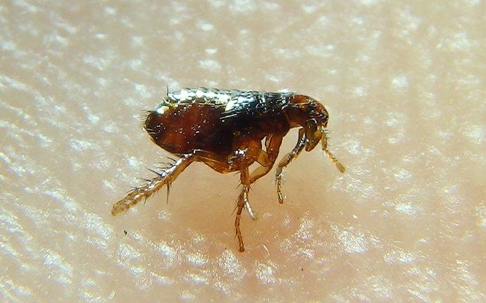Fleas can be a persistent nuisance in homes, particularly in regions like the Bay Area. To effectively control these pesky insects, it's essential to understand their life cycle, the hazards they pose, and the preventive measures you can take. Furthermore, professional pest control services offer an innovative and reliable solution for eliminating fleas.
This comprehensive guide will delve into these crucial aspects, equipping you with the knowledge and strategies needed to keep your home void of fleas for good. For flea control in the Bay Area, you can count on our team at Bay Pest.
The Flea Life Cycle: Understanding Their Stages
Fleas have a complex life cycle; comprehending it is vital for effective control. This understanding enables you to target not only adult fleas but also their eggs, larvae, and pupae. Here's an in-depth look at each stage:
- Egg Stage: Flea eggs are typically oval-shaped and about half a millimeter in size. They are laid by adult female fleas, often on their host (your pet) as well as the surrounding environment. Female fleas can lay hundreds of eggs in their lifetime.
- Larval Stage: Flea eggs hatch into larvae within a few days to weeks, depending on environmental conditions like temperature and humidity. Larvae are small, legless, and white, with a preference for dark, humid areas like carpets, pet bedding, and cracks in floors. They feed on organic matter, including flea feces and skin flakes.
- Pupal Stage: Larvae spin silk cocoons and enter the pupal stage. Because pupae are highly resilient and can remain dormant for weeks or even months, they are resistant to most insecticides.
- Adult Flea Stage: Adult fleas emerge from the pupal stage when they detect vibrations or carbon dioxide, indicating the presence of a potential host (a warm-blooded animal). They jump onto the host, usually your pet or even you, to feed on blood. Female fleas start laying eggs within days of feeding, completing the cycle.
Understanding the flea life cycle and active seasonality underscores the importance of treating adult fleas and addressing their eggs, larvae, and pupae to achieve long-term control.
The Hidden Dangers Of Fleas: Understanding The Hazards
Beyond being an annoyance, fleas pose various hazards, and it's essential to be aware of these risks:
- Health Risks: Flea bites can cause itching and discomfort. Individuals can sometimes develop a flea allergy due to flea saliva, leading to more severe skin reactions. Fleas can also transmit diseases such as typhus and can be vectors for tapeworms.
- Pet Health: Fleas can be particularly harmful to pets. Constant scratching can lead to skin infections, and if left untreated, severe infestations can result in anemia, especially in young or small animals.
- Home Damage: Fleas infest carpets, upholstery, and bedding, leading to wear and tear. Their feces can leave unsightly stains on fabrics and disrupt the overall hygiene of your home.
Because fleas reproduce rapidly, a few can quickly multiply into a full-blown infestation if not addressed promptly. Awareness of these problems should prompt you to act when you find an infestation.
Effective Flea Prevention: Tips For A Flea-Free Home
Preventing fleas from infesting your home is the first line of defense. Here's an in-depth look at effective preventive measures:
- Regular Pet Care: Consult a veterinarian about suitable flea prevention medication to maintain pet health. Follow their recommendations for dosage and application.
- Clean Environment: Regularly vacuum your home, paying close attention to areas where your pets spend time. Dispose of vacuum bags or empty canisters in sealed bags to prevent fleas from escaping. Wash pet bedding, blankets, and toys in hot water and dry them on high heat to eliminate fleas and their eggs.
- Yard Maintenance: Fleas can enter your home from your yard. Keep your outdoor area tidy by trimming tall grass, removing leaf litter, and addressing potential wildlife or stray animal issues. Consider professional yard treatments to reduce flea populations in outdoor spaces.
- Early Detection: Be vigilant for signs of fleas on your pets, such as excessive scratching or visible fleas in their fur. If you suspect an infestation, act promptly to prevent it from spreading.
Scheduled professional pest control services are crucial, especially in regions like the Bay Area, where flea infestations can be prevalent. Professionals like those here at Bay Pest have the expertise and equipment to assess the extent of the infestation and apply safe and effective flea treatments. We also provide guidance on preventive measures to reduce the risk of future infestations.
Professional Flea Control: A Smart And Effective Solution
When it comes to eliminating fleas for good, professional pest control is a wise choice for several reasons:
- Expertise: Pest control professionals have the training to identify the extent of the infestation and choose the most suitable treatment methods and products.
- Safe Products: At Bay Pest, we use safe and effective pesticides targeting fleas while minimizing risks to pets and humans.
- Comprehensive Approach: Professionals address all stages of the flea life cycle, ensuring long-term control and preventing reinfestations.
- Preventive Measures: Pest control experts can provide valuable advice on preventative measures to reduce the risk of future flea infestations.
A deep understanding of the flea life cycle, awareness of the hazards they pose, diligent preventive measures, and reliance on professional pest control services are key components of an effective strategy to protect your Bay Area home from fleas for good. By taking these steps, you can ensure a safe and comfortable environment for your family and pets. Call Bay Pest for the most effective flea removal service near you.

